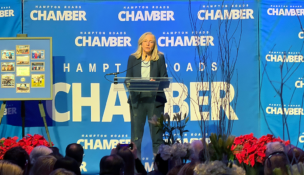Virginia Chamber releases its Blueprint Virginia 2025
The Virginia Chamber of Commerce on Friday officially delivered to Gov.-Elect Ralph Northam its wide-ranging action plan to improve Virginia’s economic climate.
Blueprint Virginia 2025, a year-long effort that included input from more than 6,000 businesses, was officially released to more than 900 attendants at the chamber’s annual Virginia Economic Summit at the Williamsburg Lodge.
“We are pleased to present Blueprint Virginia 2025 to Gov.-Elect Northam as the business community’s unified voice and plan to get Virginia back to the top state for business,” chamber CEO Barry DuVal said. “This document is the result of a collaborative process, which brought diverse, bipartisan stakeholder groups together from across the commonwealth to identify and present solutions for our state’s most pressing challenges.”
The comprehensive report provides detailed recommendations on how the commonwealth can strengthen its position as an economic leader in the global economy and improve its national business rankings.
The chamber says the effort is critical. Virginia has dropped in national business rankings, and the commonwealth’s income, employment and GDP growth rank has fallen over the past 10 years. Much of that decline can be attributed to the effects of sequestration on defense spending.
The priorities and recommendations in the plan were derived from regional briefings, chamber events, surveys and Blueprint Virginia’s industry councils.
The chamber also worked with the Virginia Economic Development Partnership, the Virginia Port Authority and GO Virginia, an initiative that supports regional economic development cooperation.
A chamber survey showed that maintaining a skilled workforce remained businesses’ No. 1 concern. The survey also showed that business owners support comprehensive tax reform, including in manufacturing, where Virginia ranks poorly for its tax climate for manufacturers.
Some of the recommendations include:
Workforce and Education:
• Improve access to affordable, high-quality early childhood education for Virginia’s working families.
• Create a public-private financing model to provide early childhood services for at-risk children.
• Use incentives to attract and retain high-need credentials and degrees.
• Support programs that increase employability and skills development for adults, including veterans and displaced workers.
• Strengthen Virginia’s labor market information infrastructure to help job seekers understand in-demand skills.
• Improve college affordability and access through strategic general fund investments.
• Enact policies that support construction of workforce housing.
Business climate:
• Support GO Virginia and endorse concept of mega-regions.
• Target economic development in growth sectors such as information technology, transportation and logistics, and high-growth manufacturing.
• Focus on agriculture and forestry economic development to grow domestic and international markets.
• Provide a more competitive film incentive program to increase television projects in Virginia.
• Enact targeted legal reforms.
• Implement a robust economic development marketing program.
• Complete a comprehensive view of the tax system.
• Place an economic development focus on rural Virginia.
Transportation:
• Develop transportation policies and investment strategies that address Virginia’s transportation challenges through multi-modal options.
• Explore new funding models and diverse revenue streams for transportation funding.
• Explore potential inland ports.
• Support the widening and deepening of Norfolk channels.
Health care:
• Advocate for expansion of health-care coverage similar to models used in states like Indiana, Michigan and Iowa.
• Improve Virginia’s health information-sharing infrastructure to improve efficiency and costs.
• Encourage collaboration on the development of innovative proposals, including funding models, to address issues such as access to behavioral health services and substance use disorder treatments.
Energy:
• Promote energy solutions, such as solar facility projects, like those of Amazon and Microsoft.
• Support an all-of-the-above approach to energy.
• Encourage development of offshore wind.
Innovation, Technology and Entrepreneurship:
• Use a two-track economic development strategy. The first targets high-growth sectors with specific focuses on business attraction, relocation and expansion. The second track would focus on startups, entrepreneurs and commercialization.
• Create a cybersecurity campus with a mandate for research and training, dedicated industry partners and private-sector applications.
• Use public-private partnerships to bring broadband to underserved areas.
Manufacturing:
• Pursue targeted tax changes to reduce the state and local effective burden on manufacturing.
• Expand incentive programs to encourage capital investments in areas where manufacturing clusters exist and can grow.
• Explore opportunities to work with surrounding states on economic development projects.
• Create project-ready sites by connecting them to infrastructure, such as broadband, energy, water, rail and highways.
• Support efforts to rebrand manufacturing to attract young people to the industry.
Environment:
• Strengthen local and state efforts to address sea-level rise in Hampton Roads.
• Support adoption of, an incentives for, sustainable business practices to reduce corporate costs, attract a strong workforce and protect natural resources.
• Support efforts to improve water quality in the Chesapeake Bay watershed through state and federal investments.
Military and Veterans Affairs:
• Develop programs to provide entrepreneurial veterans and military spouses access to education, mentorship and capital.
• Encourage development of credit-for-prior-learning models that help veterans earn credentials in a shorter timeframe based on their military experience.
The chamber released its first Blueprint Virginia in 2013, a guide the chamber credited Gov. Terry McAuliffe for using through his term to enact business-friendly legislation and policies.
P
















